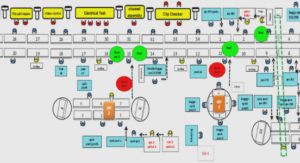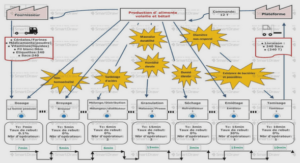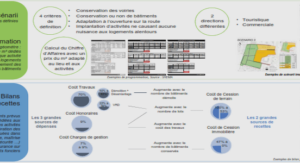UNDERSTANDING FLOOD RISK AS A NATURAL HAZARD
Considering many discussions from several authors within the last decades, we are going to consider one definition which addresses us to focus in ongoing context of natural hazards. In this way, the term of natural hazard that has been defined by D. Alexander7 , will take into consideration four ways: A naturally occurring or man-made geologic condition or phenomenon that presents at risk or is a potential danger to life or property. An interaction of people and nature governed by the co-existent state of adjustment of the human use system and state of nature in the natural events system. Those elements in the physical environment which are harmful to man and caused by force extraneous to him. The probability of occurrence within a specified period of time and within a given area of a potentially damaging phenomenon. Based on previous definition, the natural hazard concept will consider people as a main factor involved it, first of all as a victim. However, it is changing due to those last catastrophes as Katrina hurricane, Fukushima tsunami and recently Sandy hurricane, show us what thorough several factors the human being indirectly to become a driver of disasters. A clear example about it is global warming context8 . In this way we should also be able to recognize the roots of the problem which is related to three main influences, first the earth’s physical system are constantly changing, which will produce more dramatic meteorological events such as storms, flood, drought, and extreme temperatures. Second, recent and projected changes in the demographic composition and distribution the population in the world, has as consequences greater exposure to many hazards. Third, the built environment, related to public utilities, transportation systems, communications, and homes and office buildings, are growing in density, making the potential losses from natural forces larger (D. Mileti 1999). Thus the aim should be to improve the conditions of this relation among human beings and nature. It will be framed into the contemporary context of our cities, achieving to identify features in each of them in order to develop growing process model but being taken natural hazards a role important part of it. As main concept concerning natural hazard is risk. It is becoming misunderstanding due to several meanings given from wide range of disciplines and activities relating with economical, environmental and social issues. For this reason to be important to make a clear distinction between the words “hazard” and “risk” (Floodsite 2005).
How flood mitigation have emerged at ongoing context
As mentioned on the introduction, few years ago the flood aims in most of the countries was focused to promote strategies in flood defense and risk prevention; in the European context for example, countries and regions were focused on flood defense (Start-flood 2012). As result, nowadays there are so many examples as well as research documents and information development about it, appearing accordingly the concept of risk management17, which has as main objective to make risk an integral part of social and economic processes being is often increased by human interference with natural hydrometeorological phenomena (D. de Wrachien, S. Mambretti, A. Sole 2008). Take previous into account; risk management approach consists of systemic actions set up in a cycle of preparedness response and recovery that should form part of any integrated water resource management (D. de Wrachien, S. Mambretti, A. Sole 2008). It can therefore be considered as the basis of flood mitigation concept. To understand better that, first of all, we are going to define the framework under flood mitigation have been involved. Thus, from literature on flood risk management referred to a chain of responses to flood risks we identify five strategies (Start-flood 2012) (See Fig. 3): Flood Risk Prevention: pro-active – spatial planning. Flood –related risks can be structurally prevented by planning as well as land use policies (“keeping people away from water”), e.g. by proactively locating housing or buildings areas at a safe distance or altitude. Flood Defense: decreasing the probability of flooding. Flood risk can be prevented by infrastructural works, dikes, dams, embankments, sluice, etc. (“keeping water away from people”), mostly referred to as “flood defense” OR “structural measures” Flood Mitigation: decreasing the consequences of flooding. Consequences of floods when they do occur can be mitigated through spatial or building orders, regulations such as conditions for building houses in flood prone areas or retention of water in the river basin (natural flood management). Flood Preparation: develop flood warning systems and prepare disaster management plans. When mitigation is not feasible or appropriate, people should prepare for eventual flood problems (e.g. evacuation plans).
Mitigation Measures
As a general model new buildings tend to suffer less from flooding than old ones. It due to the problems has been corrected after previous flood: flood control structures have been built and non-structural mitigation measures instigated slowly over time. On another hand damages in urban space tend to affects to publics services such as sewerage, public lighting, roads, runways and urban furniture. Most of them will spend short period of time (or long) to be corrected, it according to the city’ resources (D. Mileti 1999). In later years urban sprawl has often preceded the necessary environmental protection measures. Moreover, pressures on land and the rates of expansion are going to affect considerably into the cities and the growth itself (D. Mileti 1999). Therefore, taking above into account, we are going to refer to the mitigation measures based on policies and activities that will reduce an area`s vulnerability to damage from disaster. These measures generally are in place before a disaster occurs and we can divide it in (D. Mileti 1999) (See Fig. 6): Structural Mitigation: It tries to keep hazards away from people and building, aiming to control the rate and flow of floodwaters to prevent damage. Non-structural Mitigation22: It allows distributing the population and the constructed environment such that their exposure to disaster losses is limited.






